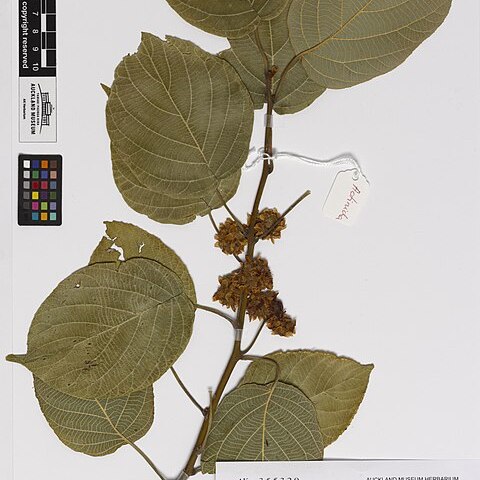Climbing shrubs, large, deciduous. Branchlets glabrous, with whitish lenticels, slightly puberulent or densely tomentose when young; pith white, lamellate, solid, or hollow. Petiole 3-7 cm, glabrous to sparsely velutinous; leaf blade abaxially pale green, adaxially green, usually broadly ovate to broadly obovate, sometimes orbicular to narrowly ovate, 8-13(-15) × 5-8.5(-12) cm, abaxially glabrescent to densely appressed stellate tomentose, adaxially glabrescent to densely puberulent, midvein and lateral veins distinct and raised abaxially, inconspicuous to subconspicuous adaxially, lateral veins 6 or 7 pairs, transverse veins distinct, base broadly cuneate to rounded, truncate or reniform, margin minutely and remotely callose-serrulate, apex acute to acuminate. Inflorescences 3-or 4-branched, 10-or more flowered, densely brownish tomentose; peduncles 2.5-8.5 cm, forked at top; pedicels 0.5-1.5 cm, elongating and enlarging at fruiting stage; bracts linear, 1-2 mm. Flowers fragrant. Sepals 5, ovate, 4-5 mm, reflexed after anthesis, both surfaces yellowish tomentose. Petals 5-8, white on upper part and margins, orange on middle of lower parts, oblong to obovate-oblong, 6-8 mm, reflexed after anthesis. Filaments 2-4 mm, slender; anthers ovoid, ca. 1 mm, sagittate at base. Ovary globose, ca. 2 mm, densely pilose; styles 2-3 mm. Fruit brown, subglobose to ovoid, 3-3.5 × 2-2.5 cm, lenticellate, glabrous when mature or only pubescent at base and apex. Seeds 2-2.5 mm. Fl. May-Jun, fr. Oct-Nov. 2n = 58*.
More
Rambling shrub or liana to 20 m long, twigs dark-coloured 5.5., innovations, inflorescences and under-surface of the leaves thinly cinnamon-(s.v. rusty-red-)stellate-tomentose. Petiole 2-4 cm; blade broad-ovate, obovate to suborbicular, 5½-11 by 3-9 cm, base reniform-cordate to rounded or cun-eate, apex acuminate, margin subentire with small callous teeth, veins rusty in distinct cross-bars, reticulations below hidden by a pale closed indumentum, upper surface puberulous. Peduncle rather stout, ± remote from the petiole, 1½-8 cm long, apex forked, ± pseudo-umbellate, rich-flowered, pedicels in fr. apparently enlarging. Flowers velvety, light-brown, yellow inside, stamens yellow (ex coll.). Only seen ♀ buds, these depressed-globose. Sepals tomentose outside. Petals pubescent outside, apex imbricating, basal parts free, blunt, rather roundish, pale green in bud apparently smaller than in A. callosa. Anthers numerous ± 1 mm long, on ½-¾ mm long filaments, sterile hardly dehiscing. Ovary depressed-globose, densely pilose, 1½ mm high. Styles ∞, ± 2 mm long, slen-der-clavate, overtopping flatly the anther clump. Berry acorn-shaped, 3-4 by 2 cm, brown, spotted pale. Seeds broad-elliptic, ± 1¾-2 by more than 1 mm.
A climber. It loses its leaves during the year. It grows up to 7 m long. The leaves are oval and 8-14 cm long by 5-10 cm wide. The flowers are pale yellow. Male and female flowers are on separate plants. The fruit are oval and 2 cm across.
Climbing into trees on mountain slopes, valleys, thickets and forests at elevations of 400-1,700 metres in China. Rather rare in hill forests at elevations from 900-1,500 metres in Malaysia.
More
Climbing into trees on mountain slopes, valleys, thickets and forests at elevations of 400-1,700 metres in China. Rather rare in hill forests at elevations from 900-1,500 metres in Malaysia.
It is a subtropical plant. It grows naturally in China in Guangxi Province. It grows on sunny hillsides. In Sichuan and Yunnan.
Hill forests, rather rare, ca 900-1500 m, fl. April-July.

